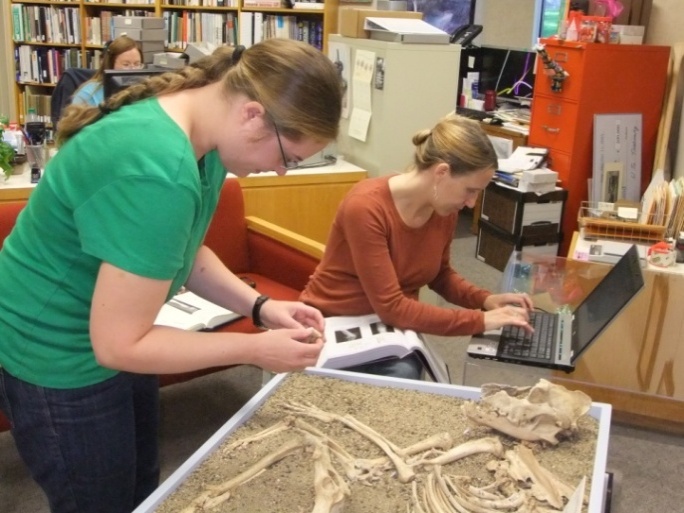Drawers of intricately beaded moccasins, illustrating traditional designs of the Dakota and Chippewa people. The original journals and letters of explorer Henry A. Boller, describing his time at Fort Atkinson during the mid-to late-19th century. A volunteer sorting decorated ceramic rim sherds from animal bone and stone tools. A paleontologist who uses Legos to create molds of dinosaur bones (seriously!). An archivist converting audio reels of traditional Arikara songs to digital files. A research archaeologist measuring the molars of a Bison antiquus skull to assess its age at the time of its death. Were you given a “backstage pass” to the State Historical Society of North Dakota (SHSND), these are just a few of the things you might see on a typical day!
Have you ever wondered what goes on in the offices below the Heritage Center’s State Museum?
Wonder no more! This blog will take you behind the scenes at what is shaping up to be the most spectacular museum in the Northern Plains. You will also learn that we are much more than a museum – we house the State Archives, the State Historic Preservation Office, the State Paleontologist’s office (part of the ND Geological Survey), and more. Each week, a different staff member of the SHSND or one of its partners will give you a glimpse into his or her day. You will see pics of objects and records that are not usually on display, and be privy to thoughts and conversations that can only occur in a museum setting (i.e. “Who put these stone hide scrapers on my desk?” or “Do we know anyone who might be willing to donate a grain bin?” or “Sorry, but I can’t articulate this raven skeleton until after lunch.”)
If you had walked through our office in August, you may have passed by what looked like a crime investigation scene. Streams of yellow caution tape stretched across the room, creating a barrier between passers-by and staff. People wearing blue nitrile gloves were carefully inspecting and photo-documenting bones arranged in a bin of sand. In actuality, you would have been witnessing a standard condition assessment of a nearly complete wolf-dog skeleton that is on exhibit in the new Innovation Gallery: Early Peoples. This dog was discovered in a pit at a lithic quarry site near Halliday, North Dakota. It appears to have jumped into the pit after some bison meat, and was then unable to get back out after eating. It is about 2,300 years old.

Archaeology Collections Manager Wendi Field Murray (right) and Collections Assistant Meagan Schoenfelder (left) conduct a condition assessment of a 2,300 year-old dog skeleton (photo by D. Rogness).
We cataloged each element of the dog and thoroughly documented any visible damage to the skeleton. The bones tell many stories about the animal’s life. Two fused metatarsals indicate that a previous foot injury had healed during the dog’s life. There appears to be a cancerous lesion on the sixth thoracic vertebra, and the teeth are broken and worn. The skeleton shows signs of arthritis, indicating that the dog was at an advanced age when it died.

The nearly complete skeleton of the wolf-dog hybrid found in a quarry pit near Halliday, North Dakota (photo by W. Murray).
This is just a taste of the kinds of stories and experiences we are eager to include in our new blog. We at the SHSND feel fortunate to be able to do what we do, and we are so excited to be able to share it with you! Now if you will excuse me, I need to catalog some donated steamship wreckage…
Check back with us next week!
Wendi Field Murray
Archaeology Collections Manager

